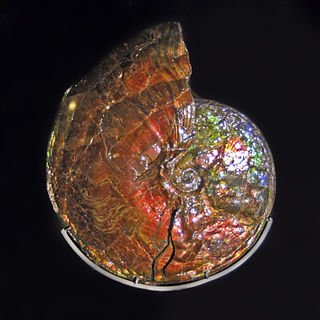
Ammonoids are extinct spiral shelled cephalopods comprising the subclass Ammonoidea. They are more closely related to living coleoids than they are to shelled nautiloids. The earliest ammonoids appeared during the Devonian, with the last species vanishing during or soon after the Cretaceous–Paleogene extinction event. They are often called ammonites, which is most frequently used for members of the order Ammonitida, the only remaining group of ammonoids from the Jurassic up until their extinction.

Acanthohoplites is an extinct genus of ammonites in the family Parahoplitidae that lived in the Aptian and Early Albian stages of the Early Cretaceous.

Astieridiscus is an extinct lower Cretaceous ammonite. Its shell evolute, covered by dense, simple or branching, slightly flexuous ribs. The sides are slightly flattened, the venter rounded. No umbilical or other tubercles except on innermost whorl. Superficially resembles Olcostephanus.

Barremites is an ammonoid cephalopod genus belonging to the family Desmoceratidae, that lived during the Hauterivian and Barremian stages of the Early Cretaceous.

Lytoceratina is a suborder of Jurassic and Cretaceous ammonites that produced loosely coiled, evolute and gyroconic shells in which the sutural element are said to have complex moss-like endings.

Desmoceratidae is a family belonging to the ammonite superfamily Desmoceratoidea. They are an extinct group of ammonoids, shelled cephalopods related to squid, belemnites, octopuses, and cuttlefish, and more distantly to the nautiloids, that lived between the Lower Cretaceous and Upper Cretaceous.

Ammonitina comprises a diverse suborder of ammonite cephalopods that lived during the Jurassic and Cretaceous periods of the Mesozoic Era. They are excellent index fossils, and it is often possible to link the rock layer in which they are found to specific geological time periods.
Heteroceras is a genus of Lower Cretaceous heteromorph ammonites belonging to the ancyloceratoidean family, Heteroceratidae.

Hoploscaphites is an extinct ammonite genus from the Upper Cretaceous and the Lower Paleocene, included in the family Scaphitidae.
Zetoceras is an extinct ammonoid cephalopod genus from the suborder Phylloceratina that lived during the Early and Middle Jurassic in what is now Europe, and is included in the (family) Phylloceratidae.

Perisphinctoidea, formerly Perisphinctaceae, is a superfamily of Middle Jurassic (Bajocian) to Lower Cretaceous (Barremian) ammonites, commonly with evolute shells with strong ribbing that typically divides about mid flank before crossing the venter.

Desmoceratoidea, formerly Desmocerataceae, is a superfamily of Cretaceous ammonites, generally with round or oval-whorled shells that are mostly smooth or weakly ribbed and rarely tuberculate, but commonly with constrictions. Regarded as monophyletic, the Desmocerataceae are derived from the Phylloceratidae, splitting off in the Early Cretaceous (Valanginian) and persisting to the end of the Maastrichtian.

Placenticeratidae is an extinct family of mostly Late Cretaceous ammonites included in the superfamily Hoplitoidea, derived from the Engonoceratidae by an increase in suture complexity.

Ancyloceratidae is a family of heteromorphic ammonites that lived during the Early Cretaceous. Their shells begin as a loose spiral with whorls not touching which then turns into a straight shaft that ends in a J-shape hook or bend at end. Coarse ribbing and spines are common.

Neocomites is a genus of ammonite from the Lower Cretaceous, Berriasian to Hauterivian, and type genus for the Neocomitidae.

Neocomitidae is a family of Lower Cretaceous ammonitids comprising genera with strongly ribbed evolute to smooth, fairly involute shells.
Pseudohaploceras is a genus of desmosceratid ammonites from the Early Cretaceous; Valanginian to Albian epochs.

Turrilites (Turrilites) costatus is a species of helically coiled ammonoid cephalopod, from the lower part of the Upper Cretaceous (Cenomanian).

The Acanthoceratinae comprise a subfamily of ammonoid cephalopods that lived during the Late Cretaceous from the latter early Cenomanian to the late Turonian
Euomphaloceras is an early Upper Cretaceous ammonite genus,, included in the Acanthoceratinae until established as the type genus for the Euomphaloceratinae by Cooper, 1978.
















